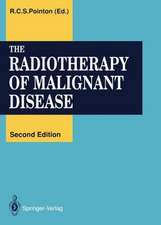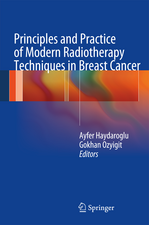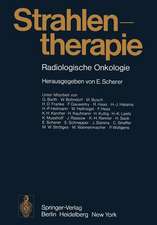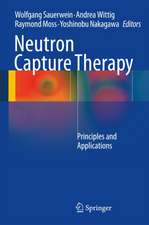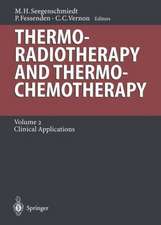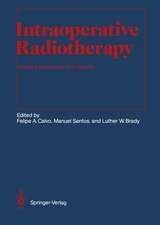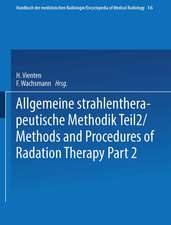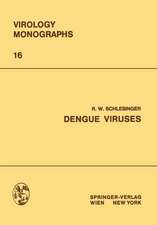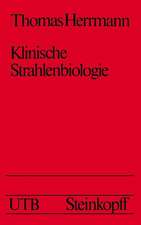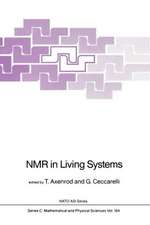Proton Beam Radiotherapy: Physics and Biology
Editat de Koji Tsuboi, Takeji Sakae, Ariungerel Gerelchuluunen Limba Engleză Paperback – 26 aug 2021
The major aspects discussed include the technique’s development background, the generation and delivery system for proton beams, physical characteristics, biological consequences, dosimetry, and future prospects in both medical physics and radiation biology in terms of effective cancer treatment. Gathering contributions from experts who provide clear and detailed information on the basics of proton beams, the book will greatly benefit not only radiological technicians, medical physicists, and physicians, but also scientists in cancer radiotherapy.
| Toate formatele și edițiile | Preț | Express |
|---|---|---|
| Paperback (1) | 715.71 lei 22-36 zile | |
| Springer Nature Singapore – 26 aug 2021 | 715.71 lei 22-36 zile | |
| Hardback (1) | 897.49 lei 38-44 zile | |
| Springer Nature Singapore – 25 ian 2020 | 897.49 lei 38-44 zile |
Preț: 715.71 lei
Preț vechi: 753.39 lei
-5% Nou
Puncte Express: 1074
Preț estimativ în valută:
136.95€ • 143.35$ • 113.99£
136.95€ • 143.35$ • 113.99£
Carte disponibilă
Livrare economică 10-24 martie
Preluare comenzi: 021 569.72.76
Specificații
ISBN-13: 9789811374562
ISBN-10: 9811374562
Pagini: 235
Ilustrații: VI, 235 p. 120 illus., 89 illus. in color.
Dimensiuni: 155 x 235 mm
Greutate: 0.42 kg
Ediția:1st ed. 2020
Editura: Springer Nature Singapore
Colecția Springer
Locul publicării:Singapore, Singapore
ISBN-10: 9811374562
Pagini: 235
Ilustrații: VI, 235 p. 120 illus., 89 illus. in color.
Dimensiuni: 155 x 235 mm
Greutate: 0.42 kg
Ediția:1st ed. 2020
Editura: Springer Nature Singapore
Colecția Springer
Locul publicării:Singapore, Singapore
Cuprins
History of proton radiotherapy and overview.- Discovery of proton and its intrinsic powers.- Initial application of proton beams to biological system and humans.- The current status of proton beam therapy.- Physical characteristics of proton radiotherapy.- Physical characteristics of proton beams.- Dosimetry of proton beams.- Trackstructure and microdosimetry of proton beams.- Qualitative comparison of proton beams with various radiotherapy beams.- Equipments and QA of proton radiotherapy.- Accelerator Systems for proton radiotherapy.- Beam delivery systems for proton radiotherapy.- Treatment planning system for proton radiotherapy.- Motion management.- Quality assurance of proton radiotherapy.- Radiobiology for proton radiotherapy.- Overview on current topics of proton radiobiology.- Energy deposition of proton beams in cells.- DNA damages, repair mechanisms and chromosome aberrations.- RBE and fractionation.- Challenge and future of proton radiotherapy.- Technological developnig issues and the future of proton radiotherapy.
Notă biografică
Dr. Koji Tsuboi became very interested in proton beam radiotherapy (PBT) soon after the Proton Medical Research Center (PMRC) was established in the University of Tsukuba in 1983, and he participated in clinical research on PBT of brain tumors. As he wanted to deepen his understanding of particle beam radiobiology, he spent two and a half years at the Life Sciences Division of the Los Alamos National Laboratory in US as a visiting scientist. Based on research achievements in the US, he became involved in research on biological effects of carbon and proton beams at Japan’s National Institute of Radiation Science and PMRC, and in 2006 he became a professor at PMRC. In the field of basic radio-biology, he has been conducting research on the targeted-effects such as DNA damage and cell death induced by various particle beams, as well as research on the non-targeted effects of activation of systemic anti-tumor immune response by proton beams. As for clinical studies, he has been involvedin high dose PBT for glioblastomas and skull base chordomas. He has many publications in both basic and clinical fields.
Dr. Takeji Sakae has continued research in the field of medical physics, which related to equipments for proton beam preparation and quality control. In this field, due to advancements such as scanning irradiation and target tracking, equipment and software have become more complicated year by year. In order for the system to obtain reliability and stability, it is considered important to have a balanced quality control that covers the entire system.
Ariungerel Gerelchuluun is a Senior Director for Clinical Research at EagleForce Associates Inc, from 2018. She had been worked as researcher and an assistant professor at University of Tsukuba, Japan. She received her MD from Health Sciences University of Mongolia, School of Medicine at 2005 and her PhD in medical sciences from University of Tsukuba, Japan at 2015. She has strong interest in radiation especially proton beam induced DNA damages and its repair mechanisms, and radiation induced anticancer immune cell modulation. She has multiple articles in this field.
Dr. Takeji Sakae has continued research in the field of medical physics, which related to equipments for proton beam preparation and quality control. In this field, due to advancements such as scanning irradiation and target tracking, equipment and software have become more complicated year by year. In order for the system to obtain reliability and stability, it is considered important to have a balanced quality control that covers the entire system.
Ariungerel Gerelchuluun is a Senior Director for Clinical Research at EagleForce Associates Inc, from 2018. She had been worked as researcher and an assistant professor at University of Tsukuba, Japan. She received her MD from Health Sciences University of Mongolia, School of Medicine at 2005 and her PhD in medical sciences from University of Tsukuba, Japan at 2015. She has strong interest in radiation especially proton beam induced DNA damages and its repair mechanisms, and radiation induced anticancer immune cell modulation. She has multiple articles in this field.
Textul de pe ultima copertă
This book offers a comprehensive, practical guide to understanding the physical and biological characteristics of proton beam radiotherapy. The application of proton beams to the treatment of solid cancers has expanded exponentially over the last decade due to their physical properties, which make it possible to administer higher doses of radiation to lesions with only a minimum dose to the surrounding healthy tissues. Accordingly, understanding the basic aspects of proton beam radiotherapy is a primary concern not only for medical physicists and radiation biologists, but also for all physicians involved in cancer treatment using proton beams.
The major aspects discussed include the technique’s development background, the generation and delivery system for proton beams, physical characteristics, biological consequences, dosimetry, and future prospects in both medical physics and radiation biology in terms of effective cancer treatment. Gathering contributions from experts who provide clear and detailed information on the basics of proton beams, the book will greatly benefit not only radiological technicians, medical physicists, and physicians, but also scientists in cancer radiotherapy.
The major aspects discussed include the technique’s development background, the generation and delivery system for proton beams, physical characteristics, biological consequences, dosimetry, and future prospects in both medical physics and radiation biology in terms of effective cancer treatment. Gathering contributions from experts who provide clear and detailed information on the basics of proton beams, the book will greatly benefit not only radiological technicians, medical physicists, and physicians, but also scientists in cancer radiotherapy.
Caracteristici
Provides comprehensive physical and biological understanding of proton beam radiotherapy Elucidates the background of the clinical application of proton beams Enriches comprehension of the theoretical underpinning of proton beam radiotherapy

